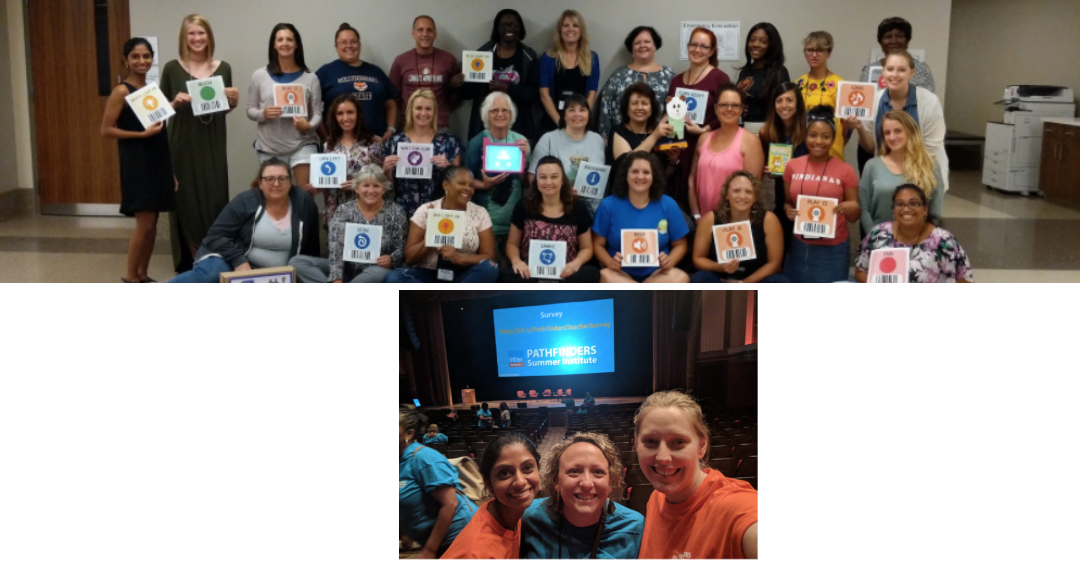
This blog post is an introduction to a six-part series of posts about supporting children’s Positive Technological Development through hybrid/distanced learning.
Full Story

Preparing for a Hybrid or Distanced Back-to-School
-
Cohorts of students / Alternating days or half days
-
Selective return of grade levels, students, or teachers
-
One course at a time
-
One room school house
-
Individual learning plans
-
Distance learning/learning from home
What is Positive Technological Development?

Figure 1. Positive Technological Development Framework. The center column shows the behaviors that children exhibit when engaging in positive uses of technology (examples in right column). These behaviors indicate the development of specific character assets (left column). Reprinted with author permission (Bers, 2018).
While Angie was learning about PTD, Amanda was working on her Ph.D. with Dr. Marina Bers as her advisor. She kept hearing from teachers at conferences and schools that they wanted a way to evaluate the learning they observed when they brought new technology into their classrooms. After using the PTD framework to develop and evaluate a new early childhood makerspace for her Ph.D. studies, Amanda compared the ways that the makerspace’s physical environment and the teachers in the space contributed to children’s positive engagement with technology.

Figure 2. Chart displaying the level of teacher and environmental support for the different dimensions of PTD, and children’s observed level of engagement with each PTD behavior. Reprinted with author permission (Strawhacker & Bers, 2018).
After this work, Amanda was convinced that the environment is another “teacher” for children, and that educators can use and shape the environment to improve children’s positive engagement with learning technologies. As we head into a hybrid or distanced back to school, it is important to remember that the environments children inhabit can be as important as the family members and educators in children’s lives.
Her results showed that the teachers and the environment were both important for children’s development, but in different and complementary ways (Strawhacker & Bers, 2018). Teachers were important for fostering children’s communication and choices of conduct, while the environment was uniquely supportive of creativity and content creation (see figure 2). Teacher actions and the physical environment supported each other to promote children’s communication and collaboration.
An Overview of this Blog Series: Bringing PTD Education into our Current Reality

Angie’s and Amanda’s paths crossed at Infosys Pathfinders Institute 2018, and since then they have continued to partner in their efforts to bring high-quality CS content and best practices to educators, families, and young children.
For each of these blog posts, we have been careful to consider the home or school learning environment, since we know how important space is for young children’s CS learning and PTD engagement.
We understand that kids live and play in a variety of environments, especially during this time. No two families will have equal access to tools, learning supports, play spaces, and time. Just like the teachers in your child’s classroom, we will do our best in this blog series to provide you with resources that you can adapt to suit your current situation.
In our upcoming blog post series, we will break down each of the six PTD behaviors that we always look for when children are engaging playfully with developmentally appropriate technologies: Communication, Collaboration, Community Building, Content Creation, Creativity, Choices of Conduct.
If you can’t wait for the blog post, check out these resources from the DevTech Research Group:
DevTech Website: http://sites.tufts.edu/devtech
Marina’s book: Bers, M.U. (2018). Coding as a Playground: Programming and Computational Thinking in the Early Childhood Classroom. New York, NY: Routledge Press.
ECT Webinar series + DevTech Webinar Recordings: http://sites.tufts.edu/devtech/biography/webinars/
Follow us on social for updates about this series and other resources that we’ll be putting out in the coming school year!
ECT Twitter: @TuftsECT
ECT Facebook: @TuftsECT
Amanda Twitter: @ALStrawhacker
Amanda website: amandastrawhacker.com
Angie Twitter: @mrskalthoff
Angie website: bit.ly/angiekalthoff
References
Bers, M.U. (2018). Coding as a Playground: Programming and Computational Thinking in the Early Childhood Classroom. New York, NY: Routledge Press.
Lerner, J. V., Phelps, E., Forman, Y., & Bowers, E. P. (2011). Positive youth development. Academic Press.
Papert, S. (1993). The children’s machine: Rethinking school in the age of the computer. BasicBooks, 10 East 53rd St., New York, NY 10022-5299.
Strawhacker, A. and Bers, M. U. (2018). Promoting Positive Technological Development in a Kindergarten Makerspace: A Qualitative Case Study. European Journal of STEM Education, 3(3) 09. doi:10.20897/ejsteme/3869
About the Authors
 Angie Kalthoff is the Product Manager for Curriculum and Instruction at Capstone. Over her career, she has been an English Language (EL) teacher, Technology Integrationist, Program Manager, and University Instructor. She has an M. Ed in Teaching and Learning. Connect with Angie on Twitter: @mrskalthoff and visit her website: bit.ly/angiekalthoff.
Angie Kalthoff is the Product Manager for Curriculum and Instruction at Capstone. Over her career, she has been an English Language (EL) teacher, Technology Integrationist, Program Manager, and University Instructor. She has an M. Ed in Teaching and Learning. Connect with Angie on Twitter: @mrskalthoff and visit her website: bit.ly/angiekalthoff. Amanda is the Associate Director of the Early Childhood Technology (ECT) Graduate Certificate Program at Tufts University’s Eliot-Pearson Department of Child Study and Human Development. She holds a Master’s and Ph.D. in Child Study and Human Development, which she earned while working at the DevTech Research Group. She has contributed to the research and development of several technologies for children including the ScratchJr programming app, the KIBO robotics kit, the Early Childhood Makerspace at Tufts, and most recently the CRISPEE bioengineering kit.
Amanda is the Associate Director of the Early Childhood Technology (ECT) Graduate Certificate Program at Tufts University’s Eliot-Pearson Department of Child Study and Human Development. She holds a Master’s and Ph.D. in Child Study and Human Development, which she earned while working at the DevTech Research Group. She has contributed to the research and development of several technologies for children including the ScratchJr programming app, the KIBO robotics kit, the Early Childhood Makerspace at Tufts, and most recently the CRISPEE bioengineering kit.She is a two-time winner of the Eliot-Pearson Research-Practice Integration Award, and was a speaker with TEDxYouth@BeaconStreet. Her work involves teaching, developing curricula, and professional development on EdTech, and she is passionate about innovating ways to empower children to express themselves and explore the world through new technologies. Connect with Amanda on Twitter: @ALStrawhacker and visit her website: amandastrawhacker.com

